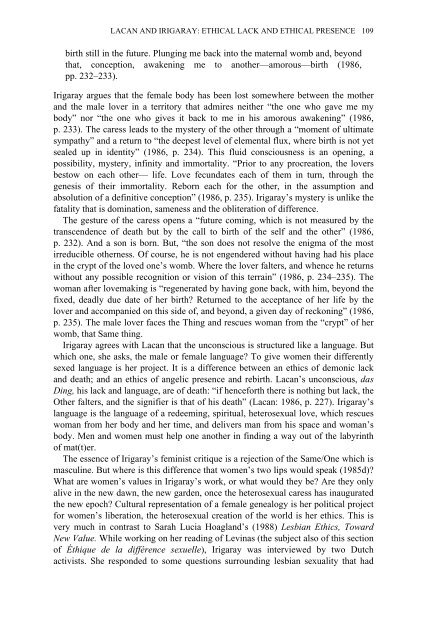Nothing Mat(t)ers: A Feminist Critique of Postmodernism
Nothing Mat(t)ers: A Feminist Critique of Postmodernism
Nothing Mat(t)ers: A Feminist Critique of Postmodernism
Create successful ePaper yourself
Turn your PDF publications into a flip-book with our unique Google optimized e-Paper software.
LACAN AND IRIGARAY: ETHICAL LACK AND ETHICAL PRESENCE 109<br />
birth still in the future. Plunging me back into the maternal womb and, beyond<br />
that, conception, awakening me to another—amorous—birth (1986,<br />
pp. 232–233).<br />
Irigaray argues that the female body has been lost somewhere between the mother<br />
and the male lover in a territory that admires neither “the one who gave me my<br />
body” nor “the one who gives it back to me in his amorous awakening” (1986,<br />
p. 233). The caress leads to the mystery <strong>of</strong> the other through a “moment <strong>of</strong> ultimate<br />
sympathy” and a return to “the deepest level <strong>of</strong> elemental flux, where birth is not yet<br />
sealed up in identity” (1986, p. 234). This fluid consciousness is an opening, a<br />
possibility, mystery, infinity and immortality. “Prior to any procreation, the lov<strong>ers</strong><br />
bestow on each other— life. Love fecundates each <strong>of</strong> them in turn, through the<br />
genesis <strong>of</strong> their immortality. Reborn each for the other, in the assumption and<br />
absolution <strong>of</strong> a definitive conception” (1986, p. 235). Irigaray’s mystery is unlike the<br />
fatality that is domination, sameness and the obliteration <strong>of</strong> difference.<br />
The gesture <strong>of</strong> the caress opens a “future coming, which is not measured by the<br />
transcendence <strong>of</strong> death but by the call to birth <strong>of</strong> the self and the other” (1986,<br />
p. 232). And a son is born. But, “the son does not resolve the enigma <strong>of</strong> the most<br />
irreducible otherness. Of course, he is not engendered without having had his place<br />
in the crypt <strong>of</strong> the loved one’s womb. Where the lover falt<strong>ers</strong>, and whence he returns<br />
without any possible recognition or vision <strong>of</strong> this terrain” (1986, p. 234–235). The<br />
woman after lovemaking is “regenerated by having gone back, with him, beyond the<br />
fixed, deadly due date <strong>of</strong> her birth Returned to the acceptance <strong>of</strong> her life by the<br />
lover and accompanied on this side <strong>of</strong>, and beyond, a given day <strong>of</strong> reckoning” (1986,<br />
p. 235). The male lover faces the Thing and rescues woman from the “crypt” <strong>of</strong> her<br />
womb, that Same thing.<br />
Irigaray agrees with Lacan that the unconscious is structured like a language. But<br />
which one, she asks, the male or female language To give women their differently<br />
sexed language is her project. It is a difference between an ethics <strong>of</strong> demonic lack<br />
and death; and an ethics <strong>of</strong> angelic presence and rebirth. Lacan’s unconscious, das<br />
Ding, his lack and language, are <strong>of</strong> death: “if henceforth there is nothing but lack, the<br />
Other falt<strong>ers</strong>, and the signifier is that <strong>of</strong> his death” (Lacan: 1986, p. 227). Irigaray’s<br />
language is the language <strong>of</strong> a redeeming, spiritual, heterosexual love, which rescues<br />
woman from her body and her time, and deliv<strong>ers</strong> man from his space and woman’s<br />
body. Men and women must help one another in finding a way out <strong>of</strong> the labyrinth<br />
<strong>of</strong> mat(t)er.<br />
The essence <strong>of</strong> Irigaray’s feminist critique is a rejection <strong>of</strong> the Same/One which is<br />
masculine. But where is this difference that women’s two lips would speak (1985d)<br />
What are women’s values in Irigaray’s work, or what would they be Are they only<br />
alive in the new dawn, the new garden, once the heterosexual caress has inaugurated<br />
the new epoch Cultural representation <strong>of</strong> a female genealogy is her political project<br />
for women’s liberation, the heterosexual creation <strong>of</strong> the world is her ethics. This is<br />
very much in contrast to Sarah Lucia Hoagland’s (1988) Lesbian Ethics, Toward<br />
New Value. While working on her reading <strong>of</strong> Levinas (the subject also <strong>of</strong> this section<br />
<strong>of</strong> Éthique de la différence sexuelle), Irigaray was interviewed by two Dutch<br />
activists. She responded to some questions surrounding lesbian sexuality that had

















